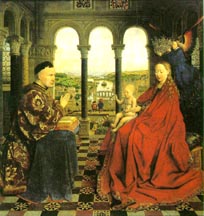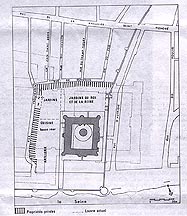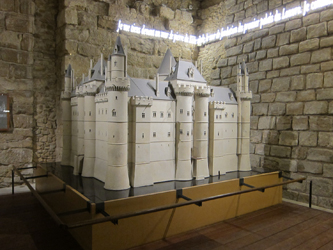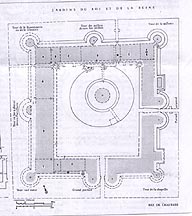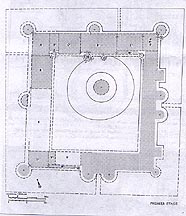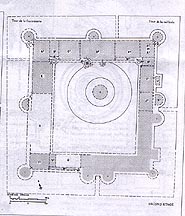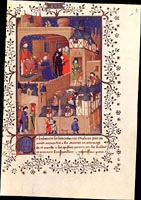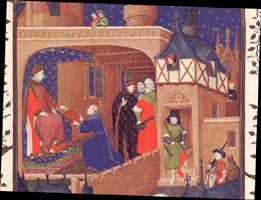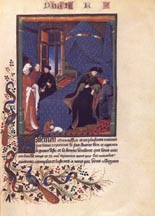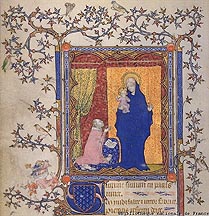Art Home | ARTH Courses | ARTH 214 Assignments | Ambassadors Home | Topics and Special Projects
Palace Design and Court Structure
An important context to explore in Late Medieval and Early Renaissance art and patronage is the elaboration of palace design and the structure of courts. Here we can gain an understanding of the social, political, and economic worlds the artists and patrons operated in. For example, a contemporary viewer of Jan Van Eyck's Rolin Madonna would have clearly understood the type of social space represented in the painting and the status of Nicholas Rolin as the Chancellor of the Duke of Burgundy. This page will examine palace design of the late fourteenth century as exemplified by the redesign by Charles V of the Louvre; the palace design of the Dukes of Burgundy; and the design of the palaces of Henry VIII of England. This sequence demonstrates the increasing elaboration of interior spaces with an increasing emphasis on the division between the monarch's public and private spaces. Concomitant with these developments in palace design there was an increasing complexity and greater hierarchical structure of the courts.
The Louvre and the Court Structure of Charles V of France
Model of the 14th century Louvre with its foundations in the background.
The October
page from the calendar of the Très riches heures of Jean de
Berry presents an invaluable visual record of the appearance of the palace
of the Louvre at the beginning of the fifteenth century. The Louvre was originally
constructed as a fortress by Philip Augustus (reigned 1180-1223).![]() In 1364 when Charles V became king he transferred his official residence from
the old palace on the Île de la Cité to the Louvre. The old palace
is represented in the background of the June page of the Très riches
heures. In Raymond du Temple's redesign of the Louvre greater attention
is paid to the division of public and private spaces. This reflects a major
shift in focus in palace design away from the Hall to the ruler's Chamber.
The ground floor of the Louvre housed the more public spaces:
In 1364 when Charles V became king he transferred his official residence from
the old palace on the Île de la Cité to the Louvre. The old palace
is represented in the background of the June page of the Très riches
heures. In Raymond du Temple's redesign of the Louvre greater attention
is paid to the division of public and private spaces. This reflects a major
shift in focus in palace design away from the Hall to the ruler's Chamber.
The ground floor of the Louvre housed the more public spaces:
 The
major entrance to the Louvre was through the Grand Portail in the
middle of the south range, while the principal spaces on the ground floor
were located in the west range. Here were located the grande salle
and the grande chambre du roi. The grande chambre was used on
special occasions when the proceedings of the great council were intended
to be heard publicly. Adjacent to this room was the grande salle used
by the King on the occasion of great feasts. The grande salle was a
little over 30 meters in length which was small for late medieval standards
where the average grande salle measured between 40 and 50 meters. The
grande salle of the old palace on the Île de la cité
measured 73 meters in length. It would be there that major feasts and great
ceremonies would be held such as the Imperial Visit of 1378. The great hall
in Jean de Berry's palace of Poitiers gives us an idea of the nature of the
space of the Louvre's grande salle. The dias elevated above the rest
of the space by three steps was given extra focus by the addition of an imposing
three hearth fireplace.
The
major entrance to the Louvre was through the Grand Portail in the
middle of the south range, while the principal spaces on the ground floor
were located in the west range. Here were located the grande salle
and the grande chambre du roi. The grande chambre was used on
special occasions when the proceedings of the great council were intended
to be heard publicly. Adjacent to this room was the grande salle used
by the King on the occasion of great feasts. The grande salle was a
little over 30 meters in length which was small for late medieval standards
where the average grande salle measured between 40 and 50 meters. The
grande salle of the old palace on the Île de la cité
measured 73 meters in length. It would be there that major feasts and great
ceremonies would be held such as the Imperial Visit of 1378. The great hall
in Jean de Berry's palace of Poitiers gives us an idea of the nature of the
space of the Louvre's grande salle. The dias elevated above the rest
of the space by three steps was given extra focus by the addition of an imposing
three hearth fireplace.![]() This arrangement is similar to that shown in the January page from the Très
riches heures. Also located on the ground floor was the Royal Chapel.
This arrangement is similar to that shown in the January page from the Très
riches heures. Also located on the ground floor was the Royal Chapel.
It has been long observed that an important trend in fourteenth century court life was a decline in the importance of the Great Hall or grande salle and the increased importance of the ruler's chambers. Historians of late Medieval and Renaissance courts have noted the trend that as the aura and power of the monarch increased more and more emphasis was directed toward the private life of the king. This decline in the Hall and the increased importance of the private spaces is noted in William Langland's Vision of Piers Plowman from about 1362:
| Wretched is the Hall...each day in the week /There the lord and lady liketh not to sit. / Now have the rich a rule to eat by themselves /In a privy parlour...for poor men's sake, /Or in a chamber with a chimney, and leave /the chief hall that was made for meals,/ for men to eat in. |
This shift from the Hall to the Chamber is reflected in the plans of the late Medieval and Renaissance palaces where the primary site of architectural innovation is in the spaces of the King's Chambers. Raymond du Temple's redesign of the Louvre reflects this trend. This is evident in the creation of a monumental stairway, the grande vis, that provided access to the more private spaces of the Louvre. The formality of this stairway was accentuated by being placed on the central axis of the palace directly opposite the Grand Portail. This plan effectively by-passes the grande salle, the old locus of power.
Separate lodgings were provided for the King and Queen as well as for the Dauphin. The King's chambers were located on the second floor of the north range directly above those of the Queen on the first floor. The Dauphin's chambers were located on the second floor of the east range adjacent to the King's. The same disposition of chambers was found in both the King's and Queen's lodgings. This can be diagrammed as follows:
|
Chambre du roi |
<-Chambre de retrait |
<- Chambre à-> parer |
Salle->
|
2
chambres
|
|
^ grande vis |
||||
The grande vis opened directly into the chambre à parer, and from there on through to the chambre de retrait and to the chambre du roi. The sequence of three rooms (chambre à parer, chambre de retrait, and the chambre du roi) were the principal rooms intended for the daytime use of the king. Adjacent to the chambre du roi was the Tour de la fauconnerie in which was housed Charles V's library. The chambre à parer or the chambre de parement was the great state room. Accounts refer to a petite chapelle du roy and son oratoire. To the west of the chambre à parer were the rooms designed for the nightime use of the king.
This division between the more public spaces of the ground floor and the more private spaces of the king's chambers reflects the major division in the structure of the court into two main areas: the service side of the Hall and kitchens and so on which was under the control of the Lord Steward, and the king's apartment or Chamber which was under the direction of the Lord Chamberlain. The Steward was responsible largely for the management of the household while the Chamberlain and his staff handled public ceremonies and provided the king's private service. The English court which was modeled on the French court made the same division of the household with domain of the Steward being designated as the Domus Providencie (the Hall) while that of the Lord Chamberlain was the Domus Regie Magnificencie (the Chamber). This twofold structure is reflected in the frontispiece of a text by Pierre Salmon dated to about 1410:
|
Pierre
Salmon, Dialogues, Paris, Bibliothèque nationale, fr.
23279 fol. 53. This miniature opens the Third Part of Salmon's text.
After 1409.
|
|
The miniaturist here clearly divides the palace into two spaces. We see at the bottom a guard who controls access to the palace. He greets two petitioners at the gate of the palace. This outer space is the domus providencie. At the top we see another usher holding a mace and standing in a doorway decorated with the French royal arms. This usher controls direct access to the inner sanctum, the space of the King. This is the domus magnificencie. In the chamber at the top, Charles VI is enthroned and receives the text from Salmon while Jean de Berry and others look on. The room with the canopied throne can be identified as the chambre à parer or the chambre de parement, what the English called the Presence Chamber. It is here that King attended to affairs of state and received delegations and ambassadors.
A miniature in a later version of the Salmon text represents the more private space of apparently the chambre du roi:
|
Pierre
Salmon, Dialogues, Geneva ms. 165, fol. 4.
|
|
This miniature of Pierre Salmon in discussion with Charles VI shows John the Fearless, the Duke of Burgundy, holding a hammer, and a member of the Orléans family who holds a bolt from a crossbow. The third person standing between the two others is perhaps Jean de Berry. Access to the chambre du roy was more exclusive than to the chambre à parer. The inclusion of the princes of the blood in the Geneva miniature suggests this more exclusive nature of the chambre du roy. The greater privacy of this space is further suggested by the doorway partially concealed by a fleur-de-lis wall hanging on the left side of the miniature. This tapestry covering the door is like the curtains found in the presentation miniatures of Charles V where there is a comparable emphasis on privacy.
The daily life of the king was thus spent going from the more public spaces of the court as a whole to the more private spaces of his chambers. This is well demonstated by Christine de Pizan in the following account of the daily routine of Charles V:
|
I find a comparable
order in the case of our own wise King Charles, so that it seems to
me reasonable to recount his agreeable habit of leading a life well-regulated
in all respects, which should be an example to all who may follow be
it in empires, kingdoms, or important lordships for a well-ordered life.
The hour of his
rising in the morning was normally six or seven o'clock, and indeed
anyone who wanted to make use here of the language of poets might say
that just as the goddess Aurora, by her rising, rejoices the hearts
of those who see her, so the king gives pleasure to his chamberlains
and other servants appointed to attend his person [chambellans et
autres serviteurs deputez pour son corps] at that hour, for, regardless
of anything that might make it otherwise, his face was joyous. Then,
after making the sign of the cross, and very devoutly addressing his
first words to God in prayer, he exchanged with his servants, in agreeable
familiarity, some pleasant and happy remarks, so that his kindness and
gentleness would encourage even the least of them to joke and enjoy
themselves with him, / p. 237 however humble they might be. They all
enjoyed these comments and exchanges. When he had been combed, dressed,
and outfitted according to the demands of the day's program, his chaplain,
a distinguished person and honorable priest, brought him his breviary
and helped him to say his hours, according to the canonical day of the
calendar. Around eight o'clock he would go to mass, which was celebrated
each day with glorious, melodious, solemn singing. In the retirement
of his oratory low masses were sung for him. As he came out of
the chapel, all sorts of people, rich or poor, ladies or maidens, widows
or others who had problems, could make their petitions to him and he
very kindly would pause to listen to their supplications, responding
charitably to those that were reasonable or piteous. More doubtful cases
he turned over to some master of requests to examine. After this, on
appointed days, he would meet with his council, and then with some noblemen
of his own blood or some clergymen who happened to be present. If some
particular lengthy matter did not prevent him, he would go to the table
around ten o'clock. His meal was not long, for he did not favor elaborate
food, saying that such food bothered his stomach and disturbed his memory,
He drank clear and simple wine, light in color, well cut, and not much
quantity nor great variety. Like David, to rejoice his spirits, he listened
willingly at the end of his meals to stringed instruments playing the
sweetest possible music. When he had risen from table after his light
meal, all sorts of strangers and others who had come with request could
approach him. There one might find several kinds of foreign ambassadors,
noblemen, and knights, of whom there was often such a crowd, both foreign
and from his own realm, that one could scarcely turn around. Nevertheless,
the very prudent king received them all and replied to them in such
a civil manner and received each one so justly with the honor due him,
that all considered themselves content and left his presence happily....
[H]e arranged what should be done according to what was proposed to
him, or promised to solve some matter in council, forbade what was unreasonable,
accorded favors, signed letters with his own hand, gave reasonable gifts,
promised vacant offices, or answered reasonable requests. He occupied
himself with such details as these for perhaps two hours, after which
he withdrew and retired to rest for about an hour. After his rest period,
he spent a time with his most intimate companions in pleasant diversions
/ p. 238, perhaps looking at his jewels or other treasures. He took
this recreation so that excessive demands on him would not damage his
health.... Then he went to vespers, after which, if it was summertime,
he sometimes went into his gardens where, if he was in his Hotel of
Saint Paul, sometimes the queen would join him with their children.
There he spoke with the women of the court, asking news of their children.
Sometimes he received curious gifts from various places, perhaps artillery
or other armaments and a variety of other things, or merchants would
come bringing velvet, cloth of gold, and all sorts of beautiful, exotic
objects, or jewels, which he had them show to the connoisseurs of such
things among members of his family. In winter, especially, he often occupied himself by having read to him fine stories from the Holy Scriptures, or the Deeds of the Romans, or Wise Sayings of the Philosophers and such matters until the hour of supper, where he took his place rather early for a light meal. After this, he spent a short period in recreation with his barons and knights before retiring to rest. And thus in continual good order, this wise and well-bread king followed the course of his life [Excerpt from Christine de Pizan, The Book of the Deeds and Good Character of King Charles V the Wise, I.xvi, as quoted in The Writings of Christine de Pizan, ed. Charity Cannon Willard, pp. 236- 238]. |
Christine de Pizan presents an account closely mirroring this one for a day in the life of a wise princess. This account documents the king's movements from the more private and intimate spaces of his chambers to the more public and formal spaces of the palace. Attended to by chamberlains and other servants [chambellans et autres serviteurs deputez pour son corps] wakes up about six or seven. Christine emphasizes the King's "familiarity" and intimacy with his chamber servants. His chaplain would then bring him his breviary and he would say his hours. Contemporary images of patrons in prayer like the following one from the Petites heures of Jean de Berry emphasize the privacy of these devotions:
The King then left the private world of his chambers to descend the grand vis to attend mass in the grande chapelle on the ground floor. Christine's reference to the "glorious, melodious, solemn singing" that accompanied the mass highlights the more public nature of this religious devotion. The king's public activities would continue with greeting petitioners in the courtyard. This accessibility of the King which follows an old French custom draws further attention to the public nature of the ground floor with its courtyard.
Traditionally the royal house, or rather houses, for there were
many of them, were divided into two main areas: the service side of the Hall
and Kitchens and so on, under the Lord Steward; and the king's apartment or
Chamber, under the Lord Chamberlain. The Lord Steward's 'side' handled accounting
and household management; while the Chamberlain and his department both staged
public ceremony and provided the king's private service. The developments
of the fifteenth century put a strain on these arrangements. There was a general
seeking for privacy amongst the upper classes, in which the king fully shared.
...
The result was that in probably 1495 Henry VII divided the ceremonial and
personal aspects of the Chamber. The most private of his new apartments, the
Privy Chamber, was cut off from the rest; closed to all but a handful and
given a small and humble staff of its own. Henry VIII kept broadly to this
outline, but transformed the Privy Chamber's personnel. He filled the apartment
with high-born favourites and boon companions, and gave it an elaborate and
largely French structure of office. These changes were more or less complete
by 1518, and eight years later they were embodied into a new corpus of household
regulations, the Eltham Ordinances. These contrast in every way with the last
major set of household ordinances, the Black Book of Edward IV. Instead of
being traditionalist and discursive they were bold and innovatory; and instead
of dividing the household into two departments, the Household and Chamber,
they divided it into three, Household, Chamber, and Privy Chamber.
This effect was to put a frontier within the palace and to establish an equally
clear line of demarcation between those royal servants who could cross it
and those who could not. The frontier lay at the door of the Privy Chamber.
Behind lay the world of the Privy Lodgings. These got steadily larger with
Henry VIII's relentless multiplication of galleries, closets, and chambers,
and they provided for more and more of his needs: he walked in the Privy Gallery
or the Privy Garden; read in his Library, and slept in his Bedchamber. Yet
the whole area was cout of bounds to all but a handful of his servants --largely,
though not entirely, the staff of the Privy Chamber.....
p. 5: But that contact, and with it 'the sight of the royal face', was the
goal of the courtier and his raison d'être . This leads to a bold and
crucial simplification. What mattered was not so much the right of coming
within 'his grace's house.; That general access to the court was the mere
pons asinorum for the courtier. What mattered instead was the particular access
to the Privy Chamber and beyond.
D. A. L. Morgan, "The House of Policy...," in Starkey et al., The
English Court
p. 27 Georges Chastellain: "After the deeds and exploits of war, which
are claims to glory, the household is the first thing that strikes the eye,
and that which it is therefore most necessary to conduct and arrange well."
[Georges Chastellain, Oeuvres, ed. Kervyn de Lettenhove (8 vols., Brussels,
1863-66) V, p. 364]
p. 32: Indoors, deriving from the architectural structuring which allocated
the domestic commissariat of kitchen and storage to one extremity of the central
hall, and the accomodation of the lord --at once more private and more stately
--to the opposite extremity, the symbiosis of a domus providencie and a domus
magnificencie was translated into the twofold grouping of agencies headed
respectively by the Steward and the Chamberlain. What in later administrative
parlance was labelled the 'Lord Steward's Department' consisted first of the
domestic offices: Bakehouse, Pantry, Cellar, Buttery, Pitcherhouse, Spicery,
Confectionery, Wafery, Chandlery, Ewery, Laundry, Kitchen, Larder, Scaldinghouse,
Poultry, Accatery, Scullery, Saucery. Each of these had its own staff, of
differing size, smaller units being grouped with larger so that for accounting
purposes they formed seven 'charges' each answered for by a Clerk or Serjeant.
As the focus of them all was the Counting House staffed by some six clerks
headed by the Cofferer, concerned with disbursing and accounting on a day-by-day
basis, and acting as the regulating mechansim at the centre of the domestic
economy.... Above the Cofferer ranked the Treasurer and the Comptroller, who
with the Steward-- to whom 'the secondary estate and rule under the king of
all the excellent household is wholly committed' -- and the Cofferer and his
Clerks sat a 'the oard of doom...at the Green Cloth in the Counting House
as recorders and witnesses to the truth....
p. 33 Keyed into this structure of the domus providencie for purposes of provisioning
and domestic accounting and jurisdiction, but otherwise forming a distinct
nexus, was the structurally and functionally very different complex over which
the Chamberlain presided. In part this comprised specialist agencies each
with its own organization: the Chapel under its Dean, the Signet Office under
the king's Secretary, the Jewel House under the Treasurer of the Chamber and
Keeper of the Jewels, the Wardrobes of Robes and Beds, the Office of Arms
of the Heralds, the Minstrels (incorporated in 1469) and Trumpeters under
their respective Marshalls, the medical corps headed by the king's Physician
and Surgeon. But its central component was the personnel of Knights and Esquires
of the Body, Carvers, Cupbearers and Sewers, Gentlemen and Yeomen Ushers,
and Yeomen, Grooms and pages of the Chamber --a staff form whom demarcations
of departmental 'offices' do not signify.
For with the world of the Chamber we moved towards the second of the two structural
features highlighted in the contemporary literature of household treatises
and records: the discrimination of the personnel of the various parts of the
household by a vocabulary of social rank, which acts as the woof to the web
of the vocabulary of functional office. Broadly speaking (and aside from the
'chief officers' of the 'board of doom'), the social nomenclature of the staff
of the domus providencie predominantly belongs to the lower ranks of yeomen
and below, only the Serjeants of the domestic offices (and the Master Cooks
and Marshals) being on occasion styled gentlemen or esquire. In the domus
magnificie it is the higher ranks of gentleman and above which predominate:
even the king's barber, says the Black Book, is 'to be taken in the court
after that he standith in degree, gentleman, yeoman, or groom'; and in practice
the same held true of Yeomen of the Crown and Chamber.....
p. 34: Essentially, that sector of the household which more immediately formed
the king's entourage belonged --by social origin or social destination-- to
that world of gentility which was also the world of politics. The role of
the Chamber staff lay partly in the enactment of the show of ceremonial 'magnificence',
partly also in those group activities which fostered a sense of courtly culture
with its distinctive mores:
these esquires of Household of old be accustomed winter and summer, in afternoons
and in evenings, to draw to lords' chambers within court, there to keep honest
company after their cunning (i.e. knowledge), in talking of chronicles of
kings and of other policies, or in piping or harping, singing, other acts
martial, to help occupy the court and accompany strangers.
But equally, such Esquires were 'to be chosen of their possession, worship
and wisdom, also to be of sundry shires, by whom it may be know[n] the disposition
of the countries'; more particularly if they were Esquires of the body, their
'business is many secrets.' (Myers, Household, pp. 111 and 129)....Their role
as a group was to realize kingly style in its various manifestations, and
to embody the king's sense of his own role in the conduct of affairs. Accordingly,
it is necessary to explore the ways in which these men of the court related
to that wider context of political society, and thereby served as a means
to political action.
